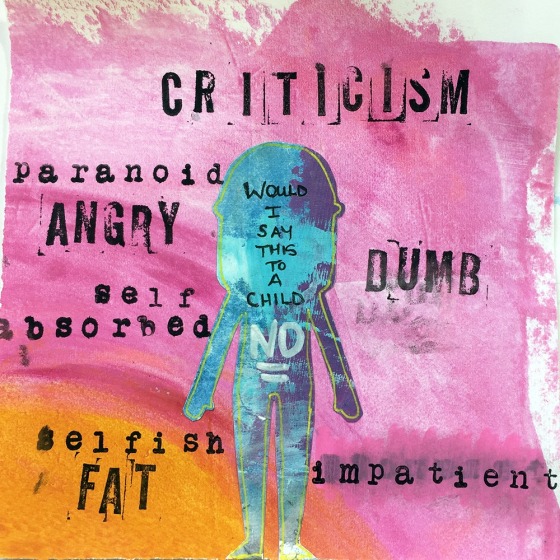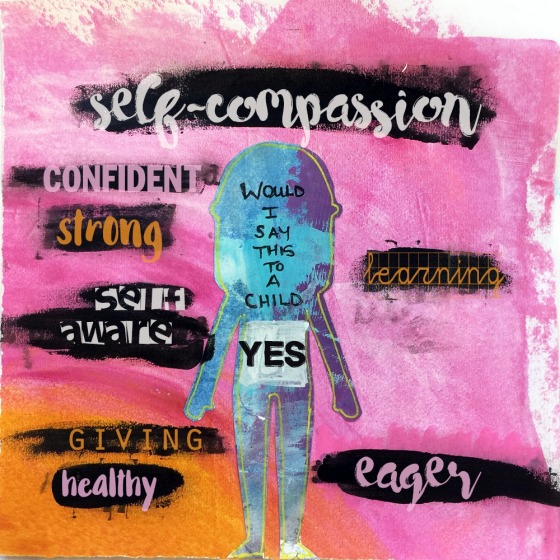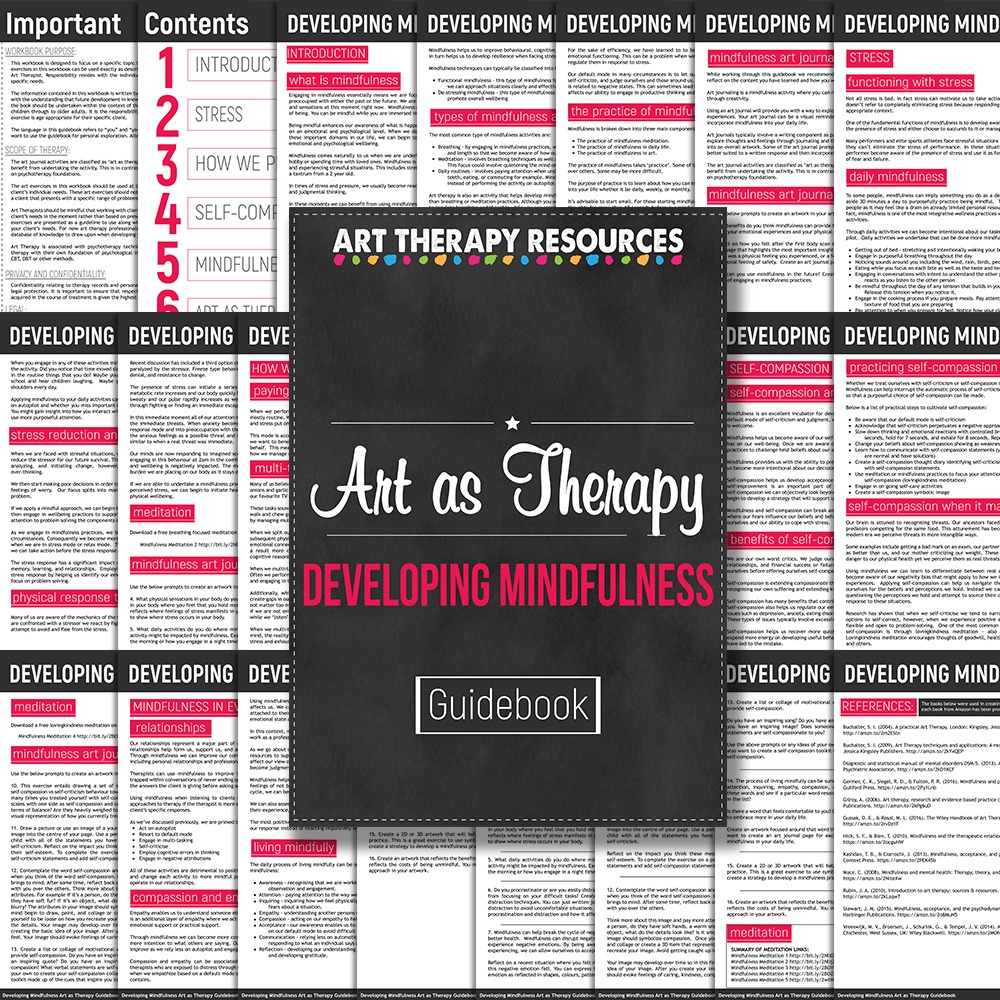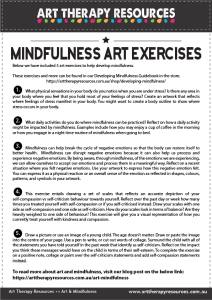THIS POST INCLUDES:
1. What is Mindfulness?
2. Art therapy and Mindfulness
3. Mindfulness Art Exercises
4. Free Download Mindfulness Art Exercises
WHAT IS MINDFULNESS?
Engaging in mindfulness essentially means we are focusing on the present moment. We are not preoccupied with either the past or the future. We are aware of our emotions, feelings, thoughts, and sensations at this moment right now. Mindfulness doesn’t signify a religious or spiritual state of being. You can be mindful while you are immersed in a hobby or enjoying a meal.
Being mindful enhances our awareness of what is happening in our lives including our experiences on an emotional and psychological level. When we develop an awareness of our interactions, we can begin to make decisions that will facilitate better emotional and psychological wellbeing.
Mindfulness may develop more naturally when we are undertaking an activity that we enjoy such as a hobby or spending time with loved ones. Mindfulness is more difficult when we are under pressure and experiencing stressful situations. This includes stress at work, sitting in traffic, or dealing with a tantrum from a 2 year old.
In times of stress and pressure, we usually become reactive or start worrying about fears, failures, and judgmental thinking.
In these moments we can benefit from using mindfulness techniques. The more we use mindfulness techniques, the more we become aware of when we become reactive and distracted. This helps us easily recognise when we need to adjust our behaviour or thoughts and regulate our emotions.
BENEFITS OF MINDFULNESS
Mindfulness helps us to be engaged in the activity we are doing and helps us to facilitate feelings of relaxation and gratitude of the time we have in a present moment. Being present and mindful while undertaking an activity provides us with many psychological and physiological benefits, including:
- Improved concentration
- Improved performance
- Decrease in physical pain from injuries
- Increase in empathy towards others
- Decrease in anxiety
- Improved emotional regulation
- Improvements in social interactions
- Improvement in general physical well being
- Increased ability to handle stressful situations
Mindfulness helps us to improve behavioural, cognitive, and emotional responses to stress and this in turn helps us to develop resilience when facing stress.
Mindfulness techniques can typically be classified into two different categories:
Functional mindfulness – this type of mindfulness focuses on improved mental function so that we can approach situations clearly and effectively
De-stressing mindfulness – this type of mindfulness focuses on reducing everyday stress to promote overall wellbeing
LIVING MINDFULLY
The daily process of living mindfully can be summarized with a few practical steps to encourage mindfulness:
- Awareness – recognising that we are working on autopilot and default mode and can change to observation and engagement.
- Attention – paying attention to the way we react and perceive situations.
- Inquiring – inquiring how we feel physically and emotionally so that we can assess our inner most fears about a situation.
- Empathy – understanding another persons emotional and physical experience.
- Compassion – acting on our empathy to help others. Providing ourselves with self-compassion.
- Acceptance – our awareness enables us to accept situations and experiences instead of acting on our default mode to avoid difficult experiences.
- Communication – relying less on automatic listening and instead intentionally listening and responding to what an individual says and not what we perceive they mean
- Reflection – developing our understanding of ourselves and our surroundings through reflection and developing gratitude.
ART THERAPY AND MINDFULNESS
TYPES OF MINDFULNESS ACTIVITIES
The most common type of mindfulness activities are:
- Breathing – by engaging in mindfulness practices, we can regulate our breathing through depth and length so that we become aware of how our body inhales and exhales air.
- Meditation – involves breathing techniques as well as an intentional effort to focus our thinking. This focus could involve quietening the mind or becoming aware of physical sensations.
- Daily routines – involves paying attention when undertaking daily routines such as brushing your teeth, eating, or commuting for example. Mindfulness helps us remain present in the moment instead of performing the activity on autopilot and becoming distracted by the past or future.
Art therapy is also an activity that helps develop mindfulness, however, it is more activity related than breathing or meditation practices. Although you are engaging in an activity you can still learn to regulate breathing and thoughts while you are creating art.
Engaging in an activity such as art allows your mind to become focused and less distracted. From a physical perspective, research indicates that those who participate in art activities show significant reduction in physical symptoms of stress.
MINDFULNESS ART JOURNAL
Art journaling is a mindfulness activity where you can relax and explore your emotional experience through creativity.
Using an art journal will provide you with a way to explore, record, reflect back on your mindfulness experiences. Your art journal can be a visual reminder of your personal growth as you begin to incorporate mindfulness into your daily life.
Art journals typically involve a writing component as part of the creative process. This can help us explore thoughts and feelings through journaling and then incorporate those thoughts and feelings into an overall artwork. Some of the art journal prompts will include direct questions that may be better suited to a written response and then incorporated into an artwork.
The art journal activities are classified as ‘art as therapy’ which is based on deriving a therapeutic benefit from undertaking the activity. This is in contrast to ‘art therapy’ which is conducted based on psychotherapy foundations.
MINDFULNESS ART EXERCISES
Below we have included 5 art exercises to help develop mindfulness. These exercises and more can be found in our Developing Mindfulness Guidebook in the store.
1. What physical sensations in your body do you notice when you are under stress? Is there any area in your body where you feel that you hold most of your feelings of stress? Create an artwork that reflects where feelings of stress manifest in your body. You might want to create a body outline to show where stress occurs in your body.
an example of this exercise is shown in the artwork below

2. What daily activities do you do where mindfulness can be practiced? Reflect on how a daily activity might be impacted by mindfulness. Examples include how you may enjoy a cup of coffee in the morning or how you engage in a night time routine of mindfulness when going to bed.
an example of this exercise is shown in the artwork below

3. Mindfulness can help break the cycle of negative emotions so that the body can restore itself to better health. Mindfulness can disrupt negative emotions because it can also help us process and experience negative emotions. By being aware, through mindfulness, of the emotions we are experiencing, we can allow ourselves to accept our emotions and process them in a meaningful way. Reflect on a recent situation where you felt negative emotions. Use your artwork to express how this negative emotion felt. You can express it as a physical reaction or an overall sense of the emotion as reflected in shapes, colours, patterns, and symbols in your artwork.
4. This exercise entails drawing a set of scales that reflects an accurate depiction of your self-compassion vs self-criticism behaviour towards yourself. Reflect over the past day or week how many times you treated yourself with self-compassion or if you self-criticised instead. Draw your scales with one side as self-compassion and one side as self-criticism. How do your scales look in terms of balance? Are they heavily weighed to one side of behaviour? This exercise will give you a visual representation of how you currently treat yourself with kindness and compassion.
an example of this exercise is shown in the artwork below

5. Draw a picture or use an image of a young child. The age doesn’t matter. Draw or paste the image into the centre of your page. Use a pen to write, or cut out words of collage. Surround the child with all of the statements you have told yourself in the past week that identify as self-criticism. Reflect on the impact you think these messages would have on the child in terms of their self-esteem. To complete the exercise on a positive note, collage or paint over the self-criticism statements and add self-compassion statements instead.
an example of this exercise is shown in the artwork below


———————————————————————————————————————————————-
These exercises and more can be found in our Developing Mindfulness Guidebook in the store.

This guidebook provides you with a foundational understanding of mindfulness including mindfulness meditation audio and art as therapy exercises.
You will receive an introduction to mindfulness including the benefits of mindfulness and the types of mindfulness activities you can undertake.
Also included in this workbook is an explanation of how stress can affect us and our performance.
The guidebook also explains the most common un-mindful ways that can affect our ability to function through multi-tasking, distraction, avoidance, and procrastination
Included in the guidebook is an important section on the importance of developing self-compassion and the benefits we gain from extending self-compassion.
The guidebook also covers how mindfulness helps us in our every day life including our relationships.
This mindfulness guidebook is written for therapists, counsellors, artists, and non-professionals who are interested in developing a more mindful approach to their lives.
Included in this guidebook, you will find 16 ‘art as therapy’ exercises to use as part of an art journaling process.
The art journal activities are classified as ‘art as therapy’ which is based on deriving a therapeutic benefit from undertaking an art activity. This is in contrast to ‘art therapy’ which is conducted based on psychotherapy foundations.
Also included in the guidebook are 5 guided meditations provided in audio format.
This guidebook is direct and easy to understand. The materials presented in the guidebook are written based on current scientific literature available.
Included in the guidebook is a comprehensive reference list of publications that were used to form the content of this guidebook.
The contents of this guidebook include:
IMPORTANT
- Workbook purpose
- Scope of therapy
- Privacy and confidentiality
- Legal
INTRODUCTION TO MINDFULNESS
- What is mindfulness
- Benefits of mindfulness
- Types of mindfulness activities
- Our default mode
- The practice of mindfulness
- Meditation – The Body Scan
- Mindfulness Art Journal
- Mindfulness Art Journal Prompts
STRESS
- Functioning with stress
- Daily mindfulness
- Stress reduction and well-being
- Physical response to stress
- Meditation – Breathing
- Mindfulness Art Journal Prompts
HOW WE PERFORM
- Paying attention
- Multi-tasking
- Distraction, avoidance, and procrastination
- Managing your emotions
- The cognitive factor
- Meditation – Body Scan and Breathing
- Mindfulness Art Journal Prompts
SELF-COMPASSION
- Self-compassion and well-being
- Benefits of self-compassion
- Practicing self-compassion
- Self-compassion when it matters most
- Meditation – Lovingkindness
- Mindfulness Art Journal Prompts
MINDFULNESS IN EVERYDAY LIFE
- Relationships
- Compassion and empathy
- Living mindfully
- Meditation – Body Scan and Breathing
- Mindfulness Art Journal Prompts
ART AS THERAPY EXERCISES
- 16 Art as Therapy Exercises
GUIDED MEDITATIONS
- 5 Guided Meditations
WORKBOOK REFERENCES
FREE DOWNLOAD: Art Therapy Exercise
SIGN UP below to download the FREE Mindfulness Art Exercises handout.

BUILD YOUR ART THERAPY REFERENCE MATERIALS:
Pin this image to your Pinterest board.

SHARE KNOWLEDGE & PASS IT ON:
If you’ve enjoyed this post, please share it on Facebook, Twitter, Pinterest. Thank you!
